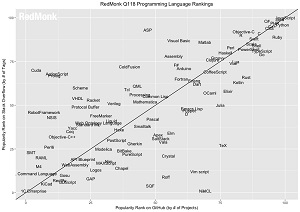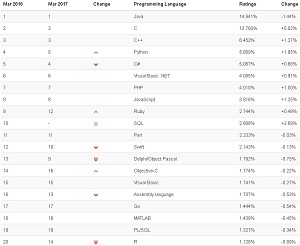News
Microsoft's Programming Language Approach Pays Off, Popularity Report Says
RedMonk's latest programming language popularity report says Microsoft's multi-language approach is paying off, giving the company the "most to crow about" among all vendors.
The report, published this week but reflecting January 2018 data, shows several Microsoft-backed languages high up in the ranking.
Here's the list of the top 20 languages, judged by the number of StackOverflow tags and number of GitHub projects:
- JavaScript
- Java
- Python
- PHP
- C#
- C++
- CSS
- Ruby
- C
- Swift
- Objective-C
- Shell
- R
- TypeScript
- Scala
- Go
- PowerShell
- Perl
- Haskell
- Lua
Noting that PowerShell gained one position, R two and TypeScript three, RedMonk weighed in on the popularity of Microsoft's programming languages.
"Of all of the vendors represented on this list, Microsoft has by a fair margin the most to crow about," RedMonk said. "Its ops-oriented language PowerShell continues its steady rise, and R had a bounceback from earlier slight declines. TypeScript, meanwhile, pulled off a contextually impressive three spot jump from #17 to #14. Given that growth in the top 20 comes at a premium, hitting the ranking that a widespread language like R enjoyed in our last rankings is an impressive achievement.
"From a macro perspective, it's also worth noting that Microsoft is seeing growth across three distinct categories in operations, analytics/data science and application development.It's a strong indication that Microsoft's multi-language approach to the broader market is paying dividends."
One reader argued that putting R in the Microsoft camp is a mischaracterization, saying: "There might be a misunderstanding here. Its being implied that R is a Microsoft language -- that is not the case. R is brought to us by the 'R Foundation' (see https://www.r-project.org/foundation/)."
In reply, another reader said: "True, but it's been the largest institution outside of the Foundation pushing R, and a lot of R's growth could be attributed to Microsoft's considerable efforts across it's stack and tooling."
This plot graphic provides more details on the latest rankings from RedMonk:
 [Click on image for larger view.]
January 2018 RedMonk Ranking (source: RedMonk)
[Click on image for larger view.]
January 2018 RedMonk Ranking (source: RedMonk)
Coincidentally, another tracker of programming language popularity, the TIOBE Index, also published its latest report this week, covering data up to March. It shows C#, Visual Basic .NET, Visual Basic and R in the top 20:
 [Click on image for larger view.]
TIOBE Index for March 2018 (source: TIOBE Index)
[Click on image for larger view.]
TIOBE Index for March 2018 (source: TIOBE Index)
You can read more about both reports at out sister publication's site, ADTmag.
About the Author
David Ramel is an editor and writer at Converge 360.